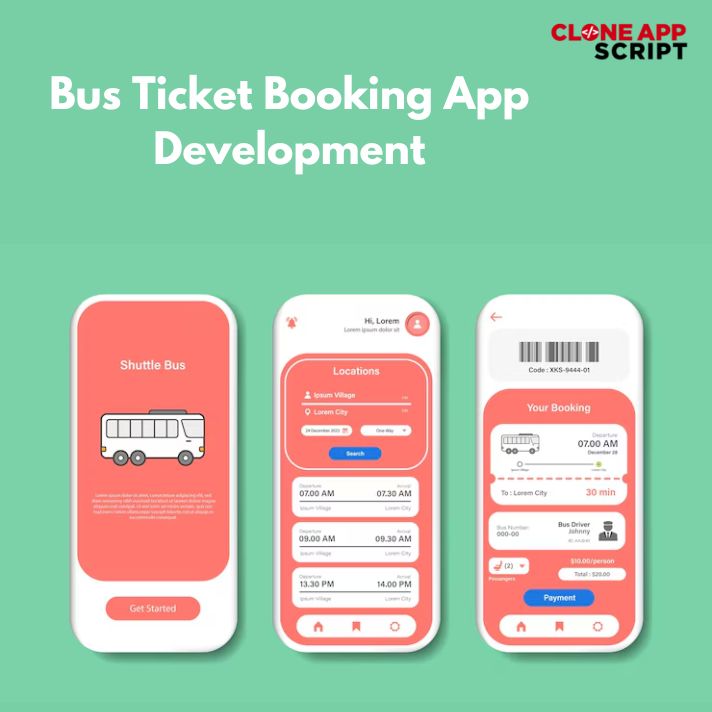With the rising demand for convenience and speed in travel, bus ticket booking cellular apps have won recognition among commuters. These apps permit travelers to e-book tickets, test schedules, and pick out seats without delay from their telephones. If you’re considering developing a bus ticket reserving cell app, this article will guide you through the essential capabilities, expected expenses, and steps concerned with the development process.
Why Develop a Bus Ticket Booking Mobile App?
The digital transformation in tour offerings has made bus price tag reserving apps enormously relevant. Not only do they offer comfort to customers, but they also provide significant enterprise advantages. Here are a few reasons why developing a bus ticket booking app is profitable:
- User Convenience: With only a few clicks, customers can e-book tickets anytime, anywhere, reducing the need to wait in line at ticket counters.
- Increased Reach: Businesses can reach a broader target market by offering digital booking options, mainly in remote regions.
- Revenue Growth: Ticket booking apps regularly include extra revenue sources like commercials, premium offerings, and loyalty programs.
- Data Insights: These apps collect personal information, which can be analyzed to understand individual oral conduct and improve offerings.
Key Features of a Bus Ticket Booking Mobile App
An ideal bus ticket booking app must be person-friendly, practical, and secure. Here are the middle features to remember:
1. User Registration and Profile Management
Allowing customers to sign in through e-mail, phone quantity, or social media guarantees a short right of entry. Once registered, users can control their profiles, view their bookings, and song past trips. Implementing a steady, clean registration process encourages user retention.
2. Bus Search and Scheduling
A search and scheduling characteristic helps customers discover buses based on departure instances, arrival instances, bus operators, and places. A clear and accurate timetable format will help customers book tickets confidently. Filters for sorting buses using rate, availability, and course can decorate the user experience.
3. Seat Selection and Real-Time Availability
Provide users with a digital seat map to pick their favored seats primarily based on availability. This function gives users control over their experience, as they can see available and booked seats in real-time.
4. Booking and Payment Options
Offer a clean reserving method that lets customers select seats, affirm bookings, and pick out from diverse charge alternatives (credit score/debit playing cards, mobile wallets, internet banking). Ensuring users accept steady, encrypted charge alternatives as accurate and protect their facts.
5. Booking History and E-Ticket Management
The app needs to keep track of all user bookings, showing upcoming journeys, past trips, and cancellations. Virtual tickets allow customers to save e-tickets on their phones and decrease the need for physical tickets.
6. Notifications and Alerts
Send push notifications and SMS signals to inform customers about reserving confirmations, bus timings, delays, and cancellations. This feature is critical for real-time communication and complements consumer experience by retaining them updated.
7. GPS Tracking and Live Bus Status
GPS monitoring allows customers to monitor actual bus locations and predicted arrival times, helping them plan their tours as accurately as possible. Live status updates can reduce tension by informing users of delays or agenda adjustments.
8. Ratings and Reviews
Encouraging customers to provide remarks about their trips and proportion rankings for bus operators promotes transparency and first-rate control. This characteristic facilitates different customers’ knowledgeable selections and allows operators to improve their services.
9. Multi-language and Currency Support
Offer alternatives in more than one language and currency for international reach. This characteristic is especially beneficial in regions with various linguistic and economic systems, making it accessible to a larger target market.
10. Customer Support
Offer customer support through in-app chat, electronic mail, or a help table to remedy customer troubles quickly. Integrating a help feature inside the app can enhance customer pride and reduce churn costs.
Steps to Develop a Bus Ticket Booking Mobile App
Developing an excellent bus price tag booking app requires a scientific approach. Here are the essential steps:
1. Conduct Market Research
Understanding the market and your opposition is vital. Identify your audience, examine competitors, and study user alternatives. Look into capabilities provided by popular apps to understand what works appropriately inside the market.
2. Define App Requirements and Features
Create an in-depth plan outlining the app’s core features, target customers, and design factors. Decide on the platform (iOS, Android, or both) and ensure you have a clean list of technical and valuable necessities.
3. Design UI/UX
The app must be intuitive, visually attractive, and user-pleasant. An expert UI/UX designer can help create a format encouraging users to effortlessly complete moves, including booking tickets. Focus on straightforward navigation and uncomplicated layouts to enhance user enjoyment.
4. Back-End Development and Integration
The lower backstop handles the app’s center functionalities, which include user registration, charge processing, seat selection, and GPS tracking. Ensure the lower back end is appropriately structured and integrates with third-party celebration services like price gateways, GPS, and messaging systems.
5. Front-End Development
The front-give-up handles the app’s visuals and user interactions. For easy user experience, ensure the front-cease is responsive and plays well throughout gadgets. Front-quit builders ensure that each visual component aligns with the UI/UX layout.
6. Testing and Quality Assurance
Testing is vital to discovering and resolving bugs, system faults, or safety vulnerabilities. Perform rigorous testing on both the front-quit and back-quit, focusing on performance, usability, and security to ensure the app functions seamlessly.
7. Launch and Marketing
Once the app passes first-class tests, it’s ready for release. Please submit it to app stores and create a marketing campaign to build awareness and appeal to customers. Use social media, search engine marketing, and paid commercials to reach your audience successfully.
8. Post-Launch Support and Updates
Continuously screen the app for user comments and roll out updates to enhance its capability and fix any emerging troubles. Regular updates help maintain the app’s relevance and improve consumer engagement.
How Much Does It Cost to Develop a Bus Ticket Booking App?
The value of growing a bus ticket reserving app varies depending on elements, app complexity, developer place, and characteristic set. Here’s a brutal fee breakdown for every stage:
- UI/UX Design: $5,000 – $15,000
- Back-End Development: $15,000 – $30,000
- Front-End Development: $10,000 – $25,000
- Testing and QA: $5,000 – $10,000
- Third-Party Integrations (Payment Gateway, GPS): $5,000 – $10,000
- Total Estimated Cost: $40,000 – $90,000
These fees can differ depending on the app’s platform (iOS or Android) and the hourly fees of the development crew. Opting for cross-platform development can reduce expenses, but native apps typically provide better overall performance, and consumers revel in it.
Conclusion
Developing a bus price ticket booking app can be a profitable investment for groups aiming to streamline the ticketing technique and decorate the consumer experience. Knowing the essential features, development manner, and related charges, you can make informed choices about bringing your app concept to life. A nicely designed, consumer-pleasant app can attract a large audience, simplify travel plans, and, in the end, make a contribution to revenue growth.
Frequently Asked Questions (FAQs)
1. How long does increasing a bus price tag booking app take?
Typically, developing a simple version of the app can take four months. However, function-rich, custom apps can take 8-three hundred and sixty-five days.
2. Which technology is generally used to build those apps?
Most bus booking apps are advanced, using frameworks like React Native or Flutter for cross-platform compatibility, while local apps can use Swift for iOS and Kotlin for Android.
3. Can I generate revenue from a bus price ticket reserving app?
Yes, you could monetize the app through service expenses, classified ads, and top-rate memberships, among other strategies.
4. How can I ensure the app is secure?
To guard user information and transactions, incorporate safety features of SSL certificates, encrypted databases, and two-issue authentication.
5. How frequently must I replace the app?
Updating the app every few months with new functions, worm fixes, and protection patches can help preserve user delight and overall performance.



